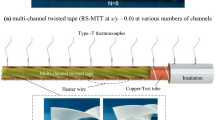Abstract
To predict the flow resistance of a compact heat exchanger with an offset strip fin, a large number of correlations have been developed and these correlations have been well used in the engineering field. Recently, three-dimensional computational analysis has been frequently used for the design and verification of heat exchangers. To improve the accuracy of three-dimensional numerical analysis and reduce the resources used for the analysis, the fins of compact heat exchangers are assumed to be a porous medium generally. To predict the flow resistance of an offset strip fin assumed to be a porous medium, the resistance must be separated into viscous and inertial resistances. However, the correlations developed so far for the offset strip fin have not been able to distinguish between these resistance types. In this paper, we propose a new friction model that can represent the flow resistance of an offset strip fin as the sum of the viscous and inertial resistances. The new friction correlation model has a maximum error of 10 % compared to existing correlation models. In addition, using the new friction model, the permeability and the Ergun constant for offset strip fins are defined as functions of offset strip fin parameters. Therefore, when predicting the flow resistance of a compact heat exchanger with an offset strip fin using three-dimensional numerical analysis, viscous and inertial resistances can be defined without additional calculations or tests for a porous medium approach.
Similar content being viewed by others
References
W. M. Kays and A. L. London, Compact heat exchangers, 2nd edition, NewYork, McGrawHill.
S. V. Manson, Correlations of heat transfer data and of friction data for interrupted plane fins staggered in successive rows, NACA technical note 2237, National Advisory Committee for Aeronautics, Washington DC (1950).
A. R. Weiting, Empirical correlations for heat transfer and flow friction characteristics of rectangular offset fin plate heat exchangers, Transactions of ASME Journal of Heat Transfer, 97 (1975) 488–497.
H. M. Joshi and R. L. Webb, Heat transfer and friction in offset strip fin heat exchanger, International Journal of Heat and Mass Transfer, 30 (1) (1987) 69–80.
R. M. Manglik and A. E. Bergles, Heat transfer and pressure drop correlations for the rectangular offset strip fin compact heat exchanger, Experimental Thermal Fluid Science, 10 (1995) 171–180.
S. Mochizuki, Y. Yagi and W.-J. Yang, Flow pattern and turbulence intensity in stacks of interrupted parallel-plate surface, Experimental Thermal and Fluid Science, 1 (1) (1988) 51–57.
Y. S. Muzychka and M. M. Yovanovich, Modeling the f and j characteristics of the offset strip fin array, Enhanced Heat Transfer, 8 (2001a) 261–267.
Y. S. Muzychka and M. M. Yovanovich, Modeling the f and j characteristics for transverse flow through an offset strip fin at low Reynolds number, Enhanced Heat Transfer, 8 (2001b) 243–259.
M.-S. Kim, J. Lee, S.-J. Yook and K.-S. Lee, Correlations and optimization of a heat exchanger with offset-strip fins, International Journal of Heat and Mass Transfer, 54 (2011) 2073–2079.
T. K. Kim, H. C. Kang and J. S. Lee, A porosity model for flow resistance calculation of heat exchanger with louvered fins, Journal of Mechanical Science and Technology, 30 (4) (2016) 1943–1948.
J. E. Hesselgreaves, Compact heat exchangers selection, Design and Operation, PERGAMON, USA (2001).
H. C. Kang and G. W. Jun, Heat transfer and flow resistance characteristics of louver fin geometry for automobile applications, Journal of Heat Transfer, 133 (2011).
M. Kaviany, Principles of heat transfer in porous media, Springer-Verlag, USA (1991).
T. K. Kim, Three-dimensional estimation of thermal and pressure drop performance of louvered-fin tube heat exchanger using porous medium approach considering inertia effect, Journal of Mechanical Science and Technology, 31 (8) (2017) 4011–4017.
Author information
Authors and Affiliations
Corresponding author
Additional information
Recommended by Associate Editor Seong Hyuk Lee
Taek Keun Kim obtained his B.S. degree from the Department of Mechanical Engineering at KOREATECH in 2001 and his M.S. degree from the Department of Mechanical Engineering at Seoul National University in 2004. He received his Ph.D. degree from Seoul National University in 2016. Dr. Kim is currently working for Hanon Systems in Korea as a Senior Researcher. His research interests include heat transfer of heat exchangers, climate control, power train cooling in cars, hybrid/ fuel cells, and computational fluid dynamics.
Rights and permissions
About this article
Cite this article
Kim, T.K. Development of friction model for offset strip fin with separated viscous and inertial resistances. J Mech Sci Technol 31, 6051–6057 (2017). https://doi.org/10.1007/s12206-017-1149-2
Received:
Revised:
Accepted:
Published:
Issue Date:
DOI: https://doi.org/10.1007/s12206-017-1149-2




